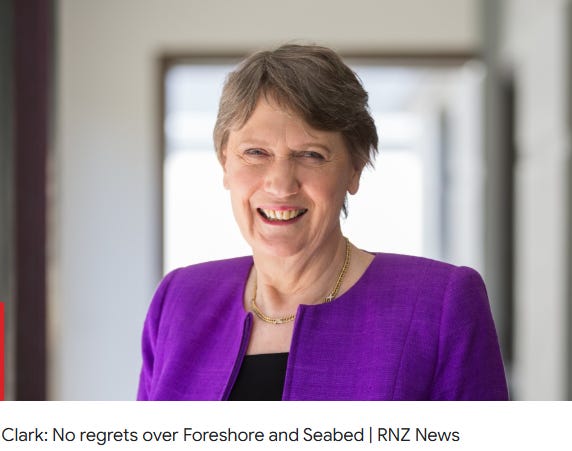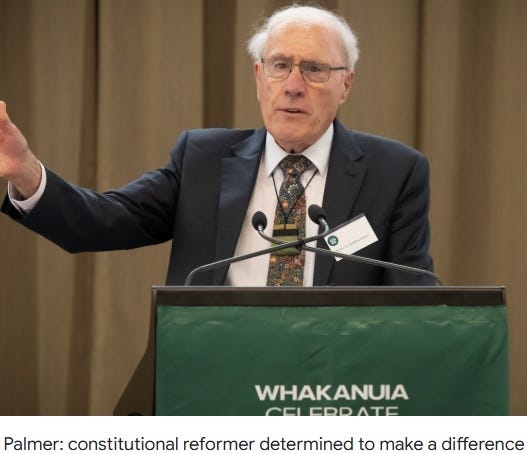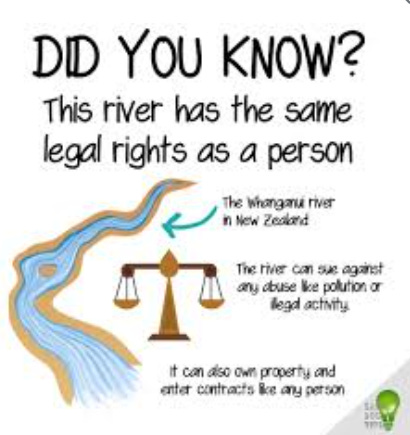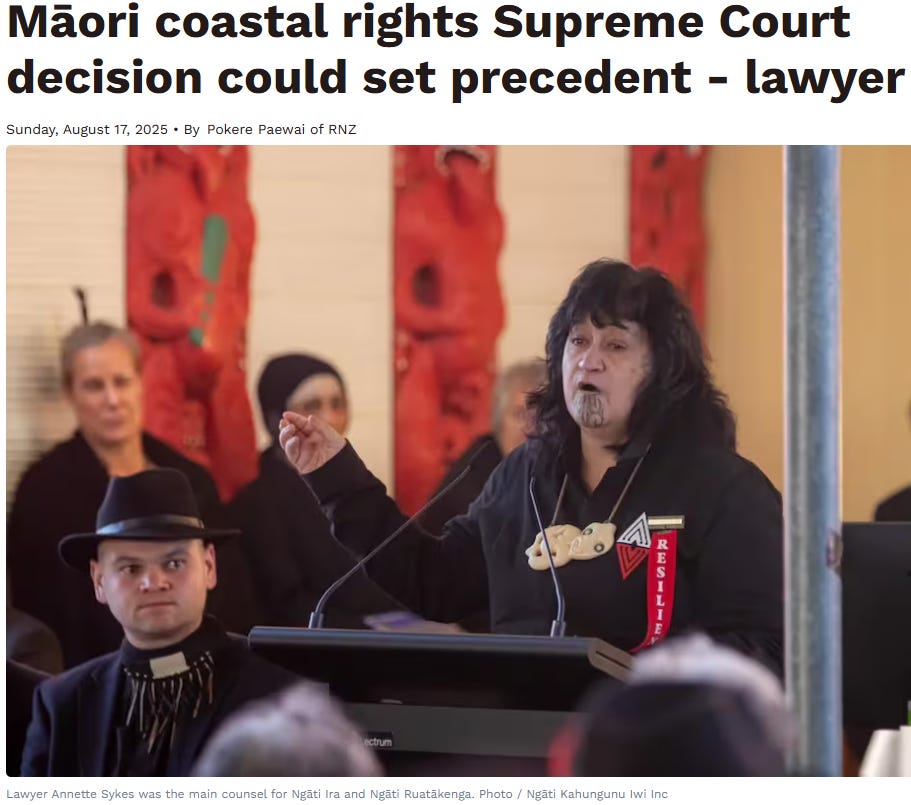New Zealand’s Supremo Judges have launched their latest salvo on the Foreshore & Seabed Front of New Zealand’s War for Constitution Supremacy. We’re talking here about the ongoing uncivil War pitting the Judiciary against successive elected Governments, on which I have previously published:

The conflict is hot and will only get hotter. Figurative flames, ballistics and scalding hot air are blasting from multiple flues, in every direction. In all the hullabaloo, woo-woo, boo-hoo and utu, few have a clue about this attempted coup. Do you?
Read full story
The Foreshore & Seabed Front dates back to 2004 when Helen Clark, as Prime Minister, put a patriotic stake in the ground for racially-blind democracy for all New Zealanders. Perplexed at the imminent prospect of New Zealand’s activist judges awarding people with fractional Māori ancestry preferential rights to New Zealand’s foreshore and seabed, Aunty Helen extinguished that prospect. She did so by arranging the enactment of the Foreshore and Seabed Act 2004. That legislation decisively vested title to all foreshore and seabed in the Crown, for the equal benefit and enjoyment of everyone regardless of racial ancestry.

Clark’s Foreshore and Seabed Act ought to have delivered enduring racial equality in the use and enjoyment of New Zealand’s foreshore and coastal waters. But Race Identitarianism is strong is Aotearoa, and The Force struck back - from an unlikely quarter. In a perverse reverse of traditional political stripes, a National Party-led Government undid Helen Clark’s unifying work. Spearheaded by then Attorney-General, shifty Chris Finlayson, and with which-ever-way-the-wind-blows Shonky John Key as Prime Minister, National replaced the Foreshore and Seabed Act with its Marine and Coastal Area (Takutai Moana) Act 2011 (MACA…”Make Aotearoa Customary Again”).
To this day, MACA continues to latch ever more carriages to the Race Gravy Freight Train, passengered by its array of race shysters, academialogues, hangers on and frothing race baiters.
MACA has spawned an ocean of Māori claims for preferential customary rights to the New Zealand’s foreshore and seabed. The end objectives of these claims are many and varied. Some Māori groups simply wish to exclude all others from the coastline they inhabit, and associated briny. More sophisticated Māori cultural elites see customary titles as razor sharp adzes to craft resource consent shake-downs (back-handers for approval of fish farming, coastal mining etc.).
Aotearoa’s Courts, with the nod and wink of Ardern’s two term Labour Government, have nailed their flag to the mast by deliberately reading down MACA’s statutory stipulations for Māori customary title to beaches and inshore coastal waters. I have already covered this sort of mendacious misreading of New Zealand’s legislation:
WOE BETIDE US WHEN PARLIAMENT’S WORDS NO LONGER MATTER
John McLean
·
19 Jun

As a child, I believed my grandmother simply started knitting, without an end in mind, and on each occasion an unforeseen woolen item would magically take shape.
Read full story
In response to the Courts’ mangling of MACA, the inert current coalition Government has mooted remedial legislation reasserting the originally-intended MACA bar for customary title. Unfortunately, Government’s Marine and Coastal Area (Takutai Moana) (Customary Marine Title) Amendment Bill, introduced in September 2024, has gone nowhere.
In an attempt to squirt squid ink and otherwise cut the Government’s proposed beaches & brine remedial legislation off at the pass, the Supreme Court has now issued a decision on Māori customary title to navigable rivers.
The Supremos latest is the second blow of a one-two punch combination designed to knock out the Government’s mooted cure for all this sandy madness. In a tortuous tome of a judgement that I strongly recommend you don’t read, our Supreme Court has decided that navigable rivers are up for indigenous grabs in the jolly MACA beach lolly scramble.
All roads lead to Aotearoa’s Rome – but New Zealand’s cultural elitist judges sometimes get to the Māori Customary Citadel different ways.
New Zealand’s lowly High Court originally rejected Māori customary claims to navigable rivers on the basis of a section of the Coal Mines Act (and predecessor legislation) that read:
Save where the bed of a navigable river is or has been granted by the Crown, the bed of such river shall remain and shall be deemed to have always been vested in the Crown
Reversing the High Court decision, the Court of Appeal decided that navigable rivers are open to claims of Māori customary title because extinguished Māori customary title to navigable river beds had been magically resurrected by section 11(3) of MACA, which provides:
On the commencement of this Act, the Crown and every local authority are divested of every title as owner, whether under any enactment or otherwise, of any part of the common marine and coastal area.
In short, the Court of Appeal decided that divesting the Crown of title to navigable rivers was sufficient in itself to resurrect Māori customary title…a significant stretch, to say the least.
The Supreme Court came to its entirely predictable decision - that Māori customary title is available for navigable rivers - for a different reason than the Court of Appeal’s. The Supreme Court got to its foregone conclusion that navigable rivers are fair game for customary claims by a more direct route. The Supremos decided that Māori customary title to navigable rivers had never been extinguished, by the Coal Mines Act or otherwise, so didn’t need to be mystically resurrected by the MACA provision set about above.
Lost, of course, in all this sound and fury and allegations of racism and inequity is that the current Government is not looking to extinguish avenues to obtain customary title to marine and coastal environments (and navigable rivers). It is simply looking to define more clearly what continuity of occupation a Māori group must have had, in order to qualify for customary title.
It would be a lovely and welcome irony if the Supreme Court’s latest attempt to sabotage the Government’s efforts to augment certainty in claims to customary rights spurs the Government into action. This can’t be allowed to go on. It’s all a divisive waste of time and human endeavour.
Actors in this Poor Play
In all this Kafkaesque, Byzantine and otherwise obscurantist judicial activism, it’s all about the people…E Tangata, E Tangata, E Tangata. Let’s sneak a peek at a few individuals at the heart of the action.
One of the Supremo judges who put his name to Supreme Court’s navigable rivers decision is Stephen Kós. (“Kós” rhymes with the posh pronunciation of “posh”). The only dissenting judgement I can find from Kós, since he was appointed a Supreme Court judge in 2022, was from the Supreme Judges’ preposterously politically partisan decision that New Zealand’s voting age of 18 breaches New Zealand’s Bill of Rights Act prohibition on age discrimination. The Majority’s decision was patently absurd given the right to vote enshrined in the Bill of Rights Act itself is confined to “Every New Zealand citizen who is of or over the age of 18 years”. In his heyday, Kós was no intellectual slouch. How he can bring himself to put his name to the Supreme Court’s succession of Critical Race Theorist decisions is anybody’s guess. More dissent please, Darth Kós!
Inveterate Māori activist Annette Sykes was naturally among the multitudes of lawyers involved in the Supreme Māori Navigable Rivers decision. Annette is a master of belittling try-hard Woke Pakehas. Back when “progressive” Pakehas were trying to move their pronunciation of Māori from Mawri to Mouldy, Annette changed it up to Maree, just to keep the White Wokesters guessing.
The name “Edwards” features strongly. Claude Augustin Edwards was an atavistic navigable rivers claimant, originally to the Waitangi Tribunal in 1989 (36 whole years ago), then under the Māori Land Act, then under the Foreshore and Seabed Act and then under MACA. Old Claude died 20 years ago, but his claim lived on, only for the Supreme Court to extinguish it because “his” hapū no longer supported it. Claude’s daughter, Karauria Augustin Edwards, is now intimately involved. Who knows quite where this Edwards fits in.

Click to view
One can scarcely imagine all the loot spent on lawyers. Who pays the ferrymen (and women) lawyers who navigate the wakas through all these murky waters?
What customary title is strictly available?
The Supreme Court sent all the extant navigable rivers claims back to the High Court, supposedly for final determination. Which begs that question, what customary title is available, if we strictly apply the letter of the law? In the Aotearoa of Activist Judges where words don’t matter, I can’t be bothered even trying to spell it all out. With the most dispassionate and incisive legal analysis, it’s impossible to define what customary titles to rivers would allow Māori groups to do, that they can’t do already.
The literal (black letter law) definition of a navigable river over which Māori customary title can be granted is clear enough. Without giving chapter and verse, customary title (assuming the prevailing legal bar is otherwise met) is limited to 1 kilometre upstream from the river mouth, or the point upstream of the mouth that is 5 times the width of the mouth – whichever is the lesser. So the whole navigable length of, say, the Whanganui River is supposedly not exposed to Māori customary title. But who really knows, given words don’t matter - and the Whanganui River is nowadays actually a person named “Te Awa Tupua” (section 14 of Te Awa Tupua (Whanganui River Claims Settlement) Act 2017). Let animism reign!

To even dip a toe into Māori customary claims to waterways is an exercise of mind-bending discombobulation. The elected Government needs to staunch the endless flow of litigation and reinforce the stop banks against future flooding.
John McLean is a citizen typist and enthusiastic amateur who blogs at John's Substack where this article was sourced.




4 comments:
Seems Helen Clark had more guts (for a more polite term) than Luxon displays
Anybody who has a grasp of history will know that at some point there will be major confrontation on these Maorification issues. In my view, it will only happen when enough people begin to see themselves as second class citizens. This could be in two years or it could be in ten years. If you read He Puapua, you can see how the goals are being reached. Land being given, education and the judicial system being taken over. Central and Local government being infiltrated. The coalition government are not halting this.
The best we can hope for is much slower progress with the present coalition. Co-governance is a fait accompli. This is because you simply must have a government opposed to apartheid to stop it. In South Africa, measures are being proposed to have jobs only accessible by Black South Africans. No jobs for Whites. This scenario is highly possible here as well with tribal rule.
A recent MACA minute from a presiding male Maca judge , I received as an interested party in this debacle stated that the procession of government paid applictions for their legal costs for the Maori only to applyfor our seabed and foreshore will continue to 2046. Happy to provide the minute. It is a fact .
Important detail: no jobs for Europeans. So this will not apply to NZers of other ethnicities.
Post a Comment
Thank you for joining the discussion. Breaking Views welcomes respectful contributions that enrich the debate. Please ensure your comments are not defamatory, derogatory or disruptive. We appreciate your cooperation.